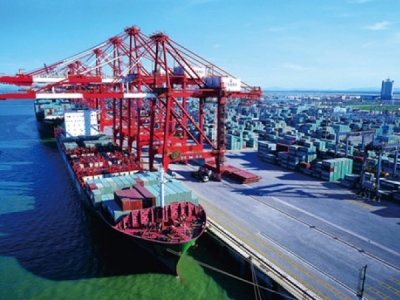
Posted on April 8, 2019
Expansion at Nansha seen as growth driver for Cosco’s ports group.
Ports operator Cosco Shipping Ports (CSP) (HKEX: 1199) has agreed to build a 254,000-square metre (2,690,978-square feet) logistics park in the city-agglomeration of Guangzhou, which has a regional population of at least 64 million people. Guangzhou is one of the world’s busiest box ports with a throughput in 2018 of 21.92 million twenty-foot container equivalents (TEU).
CSP has signed its investment agreement with the Guangzhou Nansha Economic and Technology Development Zone Commercial Bureau, which is a regional economic development agency. It operates the Nansha Free Trade Zone, which includes a 15-square kilometer port cluster, most of which is on Longxue Island, an island in the Pearl River.
Few details are available at the moment, but it appears from the comments made by CSP that the logistics park will be built next to the Nansha box terminal on Longxue Island. FreightWaves has sought confirmation on this point from CSP.
CSP wants to develop a “supply chain platform” for high-end warehousing for businesses including cross-border e-commerce, auto parts and accessories distribution, fresh food and cold chain for pharmaceutical products.
Zhang Wei, the vice chairman and managing director of CSP, said that the development “will be a new growth driver for Cosco Shipping Ports and the company will put great effort in it. Cosco Shipping Ports’ investment in port supply chain project in Nansha heralds the company’s initiative to take advantage of scarce logistics resources near the port and develop high-end warehousing business.”
Wei continued, “Compared to traditional simple warehous[ing], this high-end warehousing project near the port is irreplaceable and has a higher plot ratio and more scientific and efficient warehousing space. Located behind the container terminal, the project enjoys [a] good location, strong synergy effect and low transportation costs.”
The Nansha Port Area is the main port of Guangzhou Port. There are 16 container berths with a 5,718-meter quay length (18,760 feet; 1 meter = 3.28 feet). There are 61 quay cranes that have the ability to handle ships with 23 rows. The channel depth is 17 meters with a width of 243 meters. In 2015, the port received central government approval to widen the channel to 385 meters and that would allow two very large container ships to use the channel at the same time. However, it is unclear if this channel widening has actually happened or not. The terminal also has 57,600-square meters of on-dock warehousing and 63,000-square meters of off-dock warehousing.
Nansha Port is part of the Guangzhou Port group, which is one of the busiest ports in China – and in the world – by box volume throughput. In 2018, Guangzhou Port handled 21.92 million TEU, the fifth-busiest port in the world after Shenzhen, China (25.74 million TEU) and before Busan, South Korea (21.67 million TEU). It’s the fourth-busiest port in China just after Shenzhen and before Qingdao (19.30 million TEU). The Guangzhou Port Group looks after four container- related ports and seven container companies. These are the Downtown Port (Henan Terminal) which handles local feeder traffic for Hong Kong and Macau; Huangpu Port (Old and New) along with Xinsha Port both handle near-sea services and smaller domestic liner traffic; while Nansha handles international and larger domestic liner services.
Incidentally, it should be noted that there are, according to the wider Guangzhou group, three Nansha box terminals – Nansha with 10 box terminals; Nansha Phase 1 (a joint venture with Guangzhou Port Group, CS Terminal and Guangzhou Nansha Assets Operation Company) with four box berths and, finally, Nansha Phase II (a joint venture between Guangzhou Port Group, COSCO Pacific and APM Terminals) which has six berths. Astute readers who are adding up the numbers of berths will note that numbers of boxberths as given by Nansha Port (16) and the Guangzhou group (20) do not match. The reason for the inconsistency in berth numbers is not clear.
A note is also warranted on the city, rather, cities, in the area. Guangzhou is at the center of one of the world’s largest urban agglomerations. Guangzhou has a population of 19.4 million, and adjacent cities are large as well. Foshan to the immediate east has 7.2 million, Dongguan to the immediate north has 8.2 million, Zhongshan on the western bank of the Pearl River has 3.2 million, Jiangmen has 4.45 million, Shenzhen to the south has 13.5 million and, to the south of that, there’s Hong Kong which has 7.5 million. And there are populated areas further afield. With the exception of Hong Kong, the Nansha-Guangzhou port regards all of these areas as its hinterland.
CSP is a major world port operator. As of 31 December 2018, CSP operated and managed 283 berths at 36 ports worldwide, of which 192 were for containers. In its recently released 2018 financial reports, the company stated that it handled 117.37 million TEU, which was an increase of 17.1 percent from the previous year. CSP generated revenues of US$1 billion, a 57.6 percent increase on the previous year. This huge increase was driven by the completion of acquisitions and the consolidation of revenues. That said, its terminals also recorded large double-digit growth rates in ports around the world. It had gross pre-tax profits after cost of sales of US$293.7 million, up 40.3 percent on the previous year.
FreightWaves has contacted CSP to seek further details of the logistics park development.





